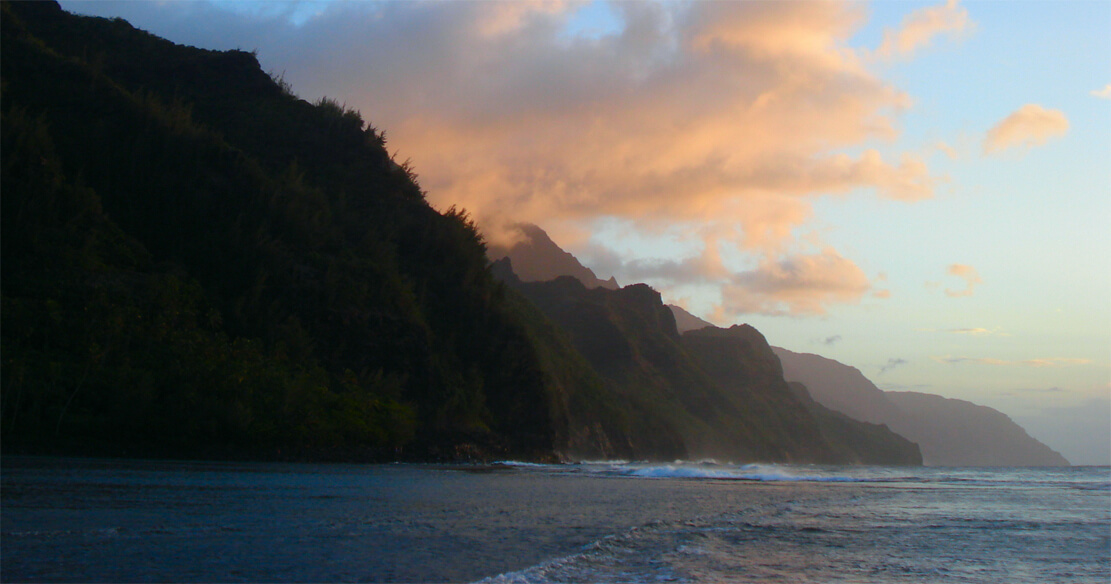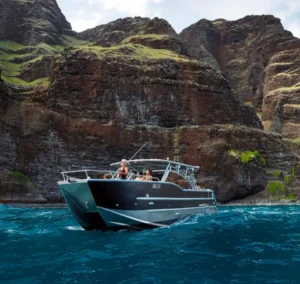The locals of Kauai have immense love and respect for dragons. Local Hawaiians love to describe the history of their island through ancient legends, often involving dragons.
Haven’t you heard of Spouting horn? The natural blowhole near Poipu that shoots water up to a height of 40ft, also has an ancient legend associated with it. The locals believe that a big lizard that used to guard the place, once got trapped inside the blowhole. The hissing sound that we hear today when the water shoots up, is believed to be the sound made by the lizard.
Respecting Kauai’s love for dragons, today, we will explore another such spot located on the north shore of Kauai. It is what the locals call it – Dragon’s Breath.
Dragon’s Breath
From the shores of Hanalei Bay, the jewel of north shore, you can spot a mountain that looks like a sleeping dragon. The mountainous ridge resembles the dragon’s back and the small profile at the end resembles its head. If you wish to see ‘Puff the dragon’, this is where you need to be. This is where the dragon’s breath is located.
Dragon’s breath falls between Kalihiwai beach and Secret beach and can be accessed from one of these beaches following a treacherous hike through steep cliffs.
Similar to the Spouting Horn, Dragon’s breath is a natural sinkhole but much grander. It is located amidst a huge lava coastline with varying rock profiles.
While one end is kissing the fierce ocean, another end of the place is serene, graced by small waterfalls, waterways and rocks that seem to balance themselves miraculously. You can call it a rocky swampland and is an ideal location for a meditation retreat. The place has great panoramic views of the ocean and has different vantage points to cherish those views.
The Gateway
The channel leading to Dragon’s breath can be divided into three sections. First, you’ll come across a small pool, which is a popular swimming spot. It looks like a natural bathtub and is a calmer version of Queens bath.
This pool leads into an open cave through a lava rock archway. This open cave is similar to the open ceiling cave in the Napali coast, but smaller with 80ft cliff Walls. This is a popular diving spot and you can often see people taking a plunge into the pool inside.
The diving pool further extends into two closed caves through a small narrow opening. Once you’ve managed to cross the opening, you’ve officially reached the dragon’s breath.
The first closed cave-pool has a small opening at the top that leads to the lava rock coastline above. Alternatively, by taking a straight plunge through the sinkhole, from above, you will land directly inside the closed cave.
But, why is this place called the Dragon’s breath?
As the fierce ocean waves make their way through different lava rock channels, they finally reach the closed caves and strike forcefully against the walls. In an attempt to pass through the final (smallest) opening, the waves create a brilliant fountain like spray. The sprayed mist escapes through the sinkhole on the top which, from above, resembles a dragon breathing out fiery smoke. Hence the name Dragon’s breath.
You can venture into the farthest cave through the small ‘keyhole’ like opening. We warn you that it is darker and narrower inside. Moreover, the powerful waves can be too tough to handle sometimes. So, proceed only if you’re an expert swimmer and are carrying a flashlight.
Conclusion
The trail leading to Dragon’s breath is a steep walk down the cliffs. Although there are ropes for assistance, it can be helpful to have a local guide accompany you. Once you climb down, you will be walking on sharp lava rocks. So, make sure you are wearing appropriate footwear.
On the way to the Dragon’s breath, you will have to cross a lava rock channel. The waves here can be powerful and trying to jump might lead to a fatal accident. Many visitors claim to have found a plank nearby to walk across the channel.
All the pain points aside, Dragon’s breath is a perfect demonstration of nature’s miraculous powers. A result of years of erosion, this is a natural masterpiece that no man can create. A seemingly unending series of caves, with one leading to another, this is nature at its very best.




